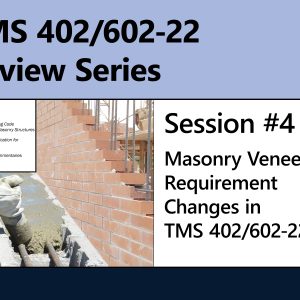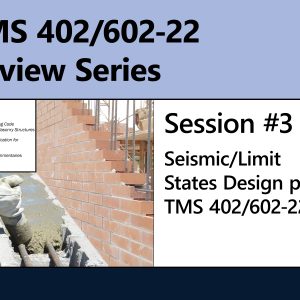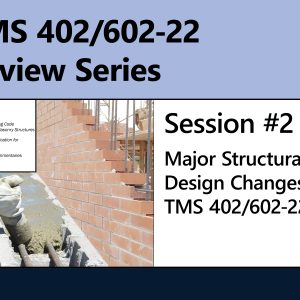© 2022 The Masonry Society. All Rights Reserved.
Custom website design by RunLocal Marketing, Longmont, CO
Exterior Masonry Walls and Energy Code Compliance

This lesson provides an overview of energy code provisions, reviews energy studies performed utilizing whole building analysis, and provides recommendations for cost effective energy efficient solutions for energy efficient exterior masonry wall designs.
$75.00
SKU
LMS1703
Categories Codes & Standards, Free for Members
Description
Achieving energy code compliance is becoming increasingly more difficult using the code prescriptive methods. Whole building analysis is one alternative method that will produce more cost effective designs for exterior masonry assemblies. This lesson provides an overview of energy code provisions, reviews energy studies performed utilizing whole building analysis, and provides recommendations for cost effective energy efficient solutions for energy efficient exterior masonry wall designs.
Learning Objectives:
- Contrast prescriptive energy code compliance with whole building analysis. Understand what building systems most affect energy use in buildings
- Describe how thermal bridging and thermal mass affect energy code compliance.
- Discuss payback cost of whole building analysis identified energy improvements.
- Understand cost effective energy efficient exterior masonry wall design.
Related products
-
Codes & Standards
TMS 402/602-22 Review #4: Masonry Veneer Requirement Changes in TMS 402/602-22, A Whole New Chapter
$80.00 Add to cartTMS 402/602-22 Review #4: Masonry Veneer Requirement Changes in TMS 402/602-22, A Whole New Chapter
The chapter on masonry veneer has been extensively revised and updated for the 2022 edition of TMS 402/602. Prescriptive requirements for both anchored and adhered veneer have been simplified with many of the major requirements now found in a one or two tables. A tributary area method was added for engineered design of anchored veneer as well as guidance for modeling anchored veneer in a full engineered design. Both the prescriptive and engineered provisions for adhered veneer were enhanced. Learn how to design masonry veneer with the new provisions and determine where your specifications need to be upgraded to meet the new requirements. Also learn about updated installation and inspection requirements and allowable tolerances for both types of veneer in construction. The updated requirements will simplify the design of your masonry veneer projects and assure the most efficient design methods are being used.
Learning Objectives:
- Learn about the updated prescriptive requirements for anchored veneer including appropriate wind loading and deflection of backing requirements as well as requirements for veneer ties and their spacing.
- Review new rational design methods for anchored veneer using the Engineered Design Methods: Tributary Area Method and Engineering Analysis Method.
- Learn about the updated prescriptive requirements for adhered veneer including unit limitations, mortar material requirements and required system components.
- Discuss needed updates to project specifications
View other courses in this series or purchase the TMS 402/602-22 Review Bundle to access all 6 and save 10% compared to buying them separately.
SKU: LMS2210 Categories: Codes & Standards, Member Discount-80, TMS 402/602-22 Review Series$80.00 -
Codes & Standards
TMS 402/602-22 Review #3: Seismic/Limit States Design per TMS 402/602-22
$80.00 Add to cartTMS 402/602-22 Review #3: Seismic/Limit States Design per TMS 402/602-22
This session of the TMS 402/602-22 Night School will review the changes to the provisions in Chapter 7 and Appendix C that effect the seismic design of masonry structures. This will include revisions to the requirements for special reinforced masonry shear walls, changes to the requirements based on the assigned Seismic Design Category, and changes made to the treatment of seismic displacements in the masonry code, including a new deformation compatibility provision. The potential impacts of these changes will also be reviewed.
Learning Objectives:
- Review the changes made in TMS 402/602-22 that affect seismic design
- Understand the technical background for the revisions to the provisions for special reinforced masonry shear walls
- Review the relationship between ASCE 7-22 seismic displacements and the TMS 402 provisions including the use of MCER displacements
- Understand the new deformation compatibility provision and its application.
View other courses in this series or purchase the TMS 402/602-22 Review Bundle to access all 6 and save 10% compared to buying them separately.
SKU: LMS2209 Categories: Codes & Standards, Member Discount-80, TMS 402/602-22 Review Series$80.00 -
Codes & Standards
TMS 402/602-22 Review #2: Major Structural Design Changes in TMS 402/602-22
$80.00 Add to cartTMS 402/602-22 Review #2: Major Structural Design Changes in TMS 402/602-22
This webinar will provide an overview of the major structural changes in TMS 402-22. One of the biggest changes was the introduction of compression-controlled sections in strength design. As a result of this, the maximum reinforcement provisions were deleted except for beams and intermediate and special shear walls under in-plane loads. The basis for the provisions, the impact on design, and some design aids will be presented.
Other structural changes that will be covered include: definition of net shear area particularly for beams, anchor bolt steel strength changing from being based on yield strength to ultimate strength, an increase of the allowable compressive force for masonry in allowable stress design, a change in the partially grouted shear wall factor, and an increase in the allowable shear friction strength as well as a change in the nominal shear friction strength for shear span ratios greater than 1. The potential impacts of these changes will also be reviewed.
Learning Objectives:
- Use the compression-controlled strength design provisions in TMS 402-22 and compare designs to TMS 402-16.
- Evaluate the change in anchor bolt steel strength in TMS 402-22
- Solve for shear friction strength for shear span ratios greater than 1 in TMS 402-22
- Name at least three other structural changes in TMS 402-22 and explain how they affect design
View other courses in this series or purchase the TMS 402/602-22 Review Bundle to access all 6 and save 10% compared to buying them separately.
SKU: LMS2208 Categories: Codes & Standards, Member Discount-80, TMS 402/602-22 Review Series$80.00 -
What’s New in LEED v4.1 – A Focus on Masonry
This course provides a summary of changes in LEED v4.1, with a focus on changes that are most likely of interest to the masonry industry.
SKU: LMS2002 Categories: Codes & Standards, Materials, Member Discount-75, Sustainability$75.00




